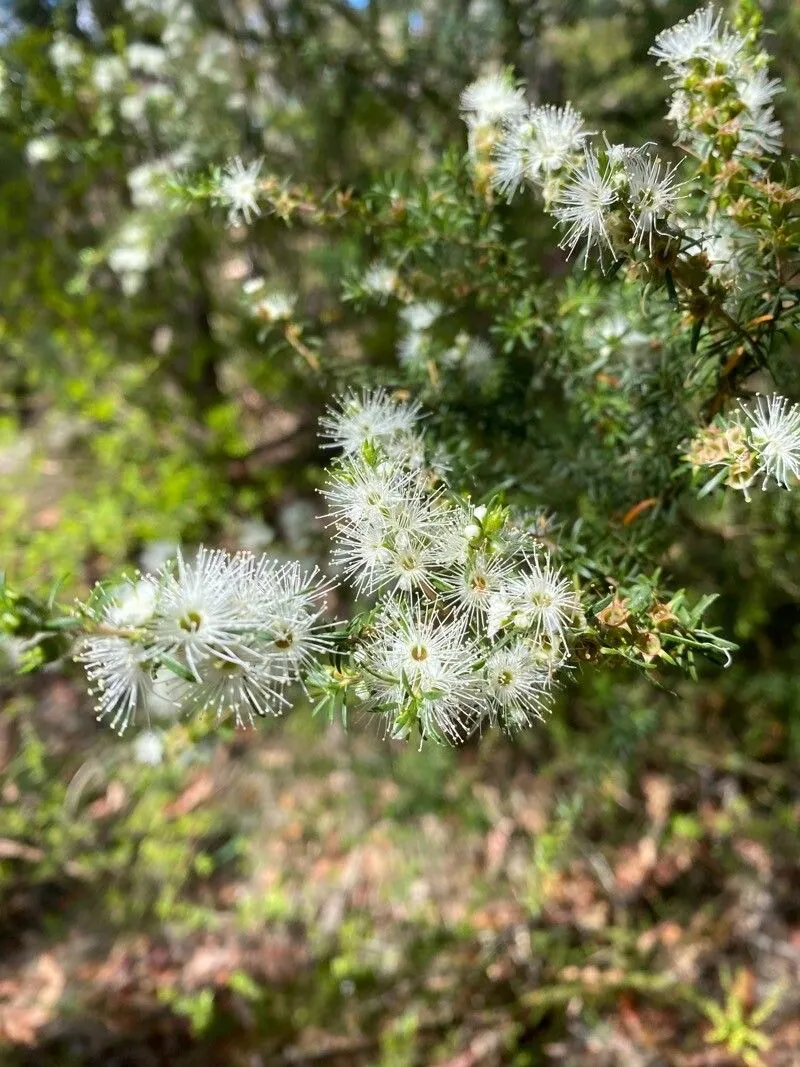
Author: (Sm.) Druce
Bibliography: Rep. Bot. Soc. Exch. Club Brit. Isles 1916: 629 (1917)
Year: 1917
Status: accepted
Rank: species
Genus: Kunzea
Vegetable: False
Observations: E. New South Wales to Victoria, NE. Tasmania
Tickbush, scientifically known as Kunzea ambigua, belongs to the Myrtaceae family. This perennial shrub is native to the regions of eastern New South Wales, extending to Victoria, and it also thrives in the northeastern parts of Tasmania.
Tickbush is renowned for its dense and vigorous growth, typically forming a significant component of the understory in its native habitats. The plant exhibits remarkable adaptability, flourishing in a variety of soil types, including sandy and well-drained soils. Its resilience to coastal conditions makes it a common sight in coastal heathlands and sclerophyll forests.
The foliage of Kunzea ambigua is notable for its small, aromatic leaves, which are often linear to narrowly elliptic in shape. These leaves are not only visually appealing with their vibrant green hue, but they also emit a pleasant fragrance when crushed, adding to the sensory experience of encountering this plant in the wild.
One of the most striking characteristics of Tickbush is its profuse blooming period, usually occurring in late spring to early summer. During this time, the shrub becomes adorned with an abundance of small, white or occasionally pinkish flowers. These blossoms are grouped in dense terminal clusters, creating a visually captivating display against the green backdrop of its foliage. The flowers are not only attractive to humans but are also a valuable nectar source for an array of pollinators, including bees and butterflies.
Kunzea ambigua has been recognized for more than its ornamental and ecological value. Indigenous cultures have historically utilized the plant for various medicinal purposes, and its essential oils are reputed for their potential therapeutic properties. Modern interest in Kunzea ambigua continues to grow, with research exploring its applications in natural medicine and aromatherapy.
First documented in scientific literature in 1917 by Druce in the “Report of the Botanical Society and Exchange Club of the British Isles”, Kunzea ambigua has since garnered attention both in horticultural circles and natural environments. Gardeners and landscapers value it for its hardy nature and its ability to provide aesthetic and functional benefits, such as erosion control and provision of habitat for native fauna.
Whether growing in the wild or cultivated in gardens, Tickbush stands as a testament to the resilience and beauty of native Australian flora. Its widespread presence from the bushland of New South Wales to the coastal stretches of Tasmania underscores its adaptability and enduring appeal.
Eng: tickbush, white kunzea
En: Tickbush, White kunzea
Ar: كونزية ملتبسة
Hr: Tik-tak grm
Taken Jul 25, 2022 by Michal Svit (cc-by-sa)
Taken Oct 26, 2022 by Sam Romeyn (cc-by-sa)
Taken Nov 18, 2022 by Pamela Mc (cc-by-sa)
Taken Nov 16, 2022 by Elise Cooke (cc-by-sa)
Taken Nov 19, 2022 by Chris Lucas (cc-by-sa)
Taken Oct 26, 2022 by Sam Romeyn (cc-by-sa)
Taken Nov 19, 2022 by Chris Lucas (cc-by-sa)
Taken Nov 16, 2022 by Elise Cooke (cc-by-sa)
© copyright of the Board of Trustees of the Royal Botanic Gardens, Kew.
Taken Oct 26, 2022 by Sam Romeyn (cc-by-sa)
Taken Nov 16, 2022 by Elise Cooke (cc-by-sa)
Family: Myrtaceae Author: (F.Muell.) K.D.Hill & L.A.S.Johnson Bibliography: Telopea 6: 402 (1995) Year: 1995 Status:…
Family: Rubiaceae Author: Pierre ex A.Froehner Bibliography: Notizbl. Bot. Gart. Berlin-Dahlem 1: 237 (1897) Year:…
Family: Sapindaceae Author: Koidz. Bibliography: J. Coll. Sci. Imp. Univ. Tokyo 32(1): 38 (1911) Year:…
Family: Asteraceae Author: A.Gray Bibliography: Pacif. Railr. Rep.: 107 (1857) Year: 1857 Status: accepted Rank:…
Family: Fabaceae Author: Medik. Bibliography: Vorles. Churpfälz. Phys.-Ökon. Ges. 2: 398 (1787) Year: 1787 Status:…
Family: Aspleniaceae Author: (Cav.) Alston Bibliography: Bull. Misc. Inform. Kew 1932: 309 (1932) Year: 1932…